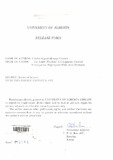The Leakey Window:A Congestion Control Technique for High-Speed Wide Area Networks

View/
Date
1992Author
Chirchir, Charles K
Type
ThesisLanguage
enMetadata
Show full item recordAbstract
Congestion control in high-speed wide area networks (HS- WAN s) is a very
important issue since the presence of congestion may have catastrophic re-
sults. Reactive mechanisms applied to existing slow speed networks are not
entirely suitable for HS-WANs due to the relatively long propagation delay.
On the other hand, preventive mechanisms which have been proposed as possible
solutions to this problem assume that traffic charateristics are known
at the time of call setup. Window mechanisms do not make such an assump-
tion, but modifications that have been proposed to adapt it to HS- VlANs fall
short of the fast response required in HS-WANs.
The Leaky Window (LW) mechanism is proposed in this thesis as an at-
tempt to solve this problem. This mechanism is a modification of the sliding
window that permits users to transmit traffic in excess of their window sizes
based on an estimate of the network load. The estimate is based on acknowl-
edgments received within a fixed time interval. Excess traffic is distinguished
by. "marking" cells. Marked celLs are discarded at congested nodes. Conges-
tion control therefore, is a local decision executed by the congested node.
Through the use of a simulation model, it is shown that the LW has an
average end-to-end delay and probability of loss that is lower than the sliding
window mechanism. Comparison to the Virtual Leaky Bucket (VLB) mech-
anism shows that at lower load (0.7), the VLB has an end-to-end delay and
a probability of loss that is lower than that of the LW under the same condi-
tions. At higher loads where congestion is a real problem, the performance
of the LW is significantly better than that of the VLB.
Citation
Chirchir,C.K.,1992.The Leakey Window:A Congestion Control Technique for High-Speed Wide Area Networks.Publisher
University of Nairobi College of Biological and Physical Sciences
